

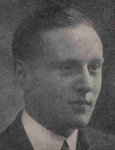
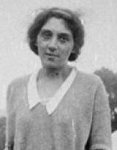 was founded in 1919 by (Sir) Basil Lucas Quixano Henriques CBE JP (1890-1961) and his wife at a disused hostel at 26a Betts Street.
Captain Basil Henriques, 6' 4" tall, was educated at Harrow and Oxford, and had served with
distinction in the 3rd Battalion of the East Kent Regiment (taking part
in the battle of Cambrai, commanding one of the earliest tanks, used en masse for the first time). Iin 1918 he published Prayers for Trench and Base for
Jewish soldiers, elements of which later formed part of the
Setttlement's prayer book [see below], and also what became its youth club prayer - akin to Compline! - When
we are asleep and when we are awake, into thy hand we commend our
spirits and with our spirits our bodies also. Thou art with us; we
shall not fear. (See here for his involvement in the creation of the war memorial at St George's.)
was founded in 1919 by (Sir) Basil Lucas Quixano Henriques CBE JP (1890-1961) and his wife at a disused hostel at 26a Betts Street.
Captain Basil Henriques, 6' 4" tall, was educated at Harrow and Oxford, and had served with
distinction in the 3rd Battalion of the East Kent Regiment (taking part
in the battle of Cambrai, commanding one of the earliest tanks, used en masse for the first time). Iin 1918 he published Prayers for Trench and Base for
Jewish soldiers, elements of which later formed part of the
Setttlement's prayer book [see below], and also what became its youth club prayer - akin to Compline! - When
we are asleep and when we are awake, into thy hand we commend our
spirits and with our spirits our bodies also. Thou art with us; we
shall not fear. (See here for his involvement in the creation of the war memorial at St George's.)
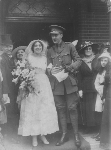
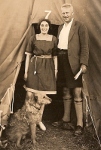

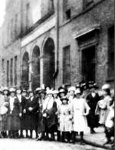
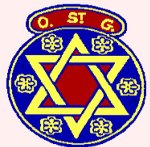 In 1914 he had established the tellingly-named Oxford & St George's Club for Jewish boys at 125 Cannon Street Road; the club badge [right] combined dark blue (Oxford), red (St George), Tudor roses (England) and
the Star of David. Rose Louise Loewe
(b.1889) had founded a similar girls' club in 1915. In 1917 they
married, and became leading figures in the community - he was 'the
Gaffer', she 'the Missus' (he called her 'Bunny'). They
advocated an assimilationist or Anglicised style of Jewish life, which
was promoted through their clubs and holiday camps (many of them at
Highdown, near Goring-on-Sea). Camps for boys and girls were separate,
and run on
traditional English lines. There, and at the clubs, they taught sports,
acting, ballet, physical education, first aid, and encouraged career
aspirations within a modern outlook on Jewish heritage. (Some former
members still meet for annual 'camps' - though in hotels!) Right are
girls outside Betts Street, and a 1926 camp meal. The Prince of Wales
visited the club in 1927 (joining in happily, it's said, with Bunny's
'Camp Songs') - he returned in 1934 to open the new flats, mentioned
below.
In 1914 he had established the tellingly-named Oxford & St George's Club for Jewish boys at 125 Cannon Street Road; the club badge [right] combined dark blue (Oxford), red (St George), Tudor roses (England) and
the Star of David. Rose Louise Loewe
(b.1889) had founded a similar girls' club in 1915. In 1917 they
married, and became leading figures in the community - he was 'the
Gaffer', she 'the Missus' (he called her 'Bunny'). They
advocated an assimilationist or Anglicised style of Jewish life, which
was promoted through their clubs and holiday camps (many of them at
Highdown, near Goring-on-Sea). Camps for boys and girls were separate,
and run on
traditional English lines. There, and at the clubs, they taught sports,
acting, ballet, physical education, first aid, and encouraged career
aspirations within a modern outlook on Jewish heritage. (Some former
members still meet for annual 'camps' - though in hotels!) Right are
girls outside Betts Street, and a 1926 camp meal. The Prince of Wales
visited the club in 1927 (joining in happily, it's said, with Bunny's
'Camp Songs') - he returned in 1934 to open the new flats, mentioned
below.


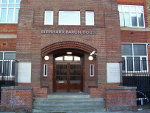 Boys
and girls came together at the Betts Street site. In 1929 the synagogue
and settlement moved to 33 Berner Street, off Commercial Road [see here for some views of the street], on the
site of a former Board School [left, showing
the netted roof for ball games - they also created a rooftop garden -
and a 2004 brochure marking the 90th anniversary of the club]. It was named Bernhard Baron House,
who provided £65,000 for its purchase - he was the founder of the
tobacco company Carreras (taken over by Gallahers), and died in 1929.
Designed by Hobden and Porri, it had 125 rooms equipped for welfare
work, a variety of skills and crafts, and recreation - catering from
cradle to grave, with a maternity clinic, toddler group, youth clubs (here
is their club cry, based on a Maori chant Bumalaka), young marrieds and
parents groups, a Friendship Club and lunch club for the elderly and a
burial scheme. There were also religious classes and other adult
activities, a diabetes clinic and first aid centre, a boot club to
provide footwear for poor children and a Poor Man's Lawyer scheme
(a precursor of the Citizens Advice Bureau). It had a well-equipped gym, and the shower room was
well-used by youngsters who had no baths at home. The
club was renowned for its sporting successes, with cricket, football,
netball and hockey teams, and coaching in swimming, PT, table tennis
and particularly boxing: the lightweight champion Harry Mizler
coached the boys' team. Next door in 1934-35 Burnett, Tait and Lorne designed Basil House, in Modernist style [right].
Boys
and girls came together at the Betts Street site. In 1929 the synagogue
and settlement moved to 33 Berner Street, off Commercial Road [see here for some views of the street], on the
site of a former Board School [left, showing
the netted roof for ball games - they also created a rooftop garden -
and a 2004 brochure marking the 90th anniversary of the club]. It was named Bernhard Baron House,
who provided £65,000 for its purchase - he was the founder of the
tobacco company Carreras (taken over by Gallahers), and died in 1929.
Designed by Hobden and Porri, it had 125 rooms equipped for welfare
work, a variety of skills and crafts, and recreation - catering from
cradle to grave, with a maternity clinic, toddler group, youth clubs (here
is their club cry, based on a Maori chant Bumalaka), young marrieds and
parents groups, a Friendship Club and lunch club for the elderly and a
burial scheme. There were also religious classes and other adult
activities, a diabetes clinic and first aid centre, a boot club to
provide footwear for poor children and a Poor Man's Lawyer scheme
(a precursor of the Citizens Advice Bureau). It had a well-equipped gym, and the shower room was
well-used by youngsters who had no baths at home. The
club was renowned for its sporting successes, with cricket, football,
netball and hockey teams, and coaching in swimming, PT, table tennis
and particularly boxing: the lightweight champion Harry Mizler
coached the boys' team. Next door in 1934-35 Burnett, Tait and Lorne designed Basil House, in Modernist style [right].

 In the mid-1920s the synagogue [left], uniquely, had affiliated both to the Movement for Reform Judaism (RSGB, 'Reform Synagogues of GB') and
the Union of Liberal and Progressive Synagogues (ULPS, which later became
'Liberal Judaism'). In 1929 it produced its own distinctive service book (preface right - some
of its features survive in its successor congregation's worship). The
style is somewhat anglicised - though perhaps not as much as that of
other Liberal
and Reform synagogues of the period - with texts set to English music
by Rose, who formed a choir with girls from the club, accompanying them
on the organ. (She also produced a club
song book, of 176 songs with new words to traditional tunes (here is
one, celebrating the start of the girls' club on 18 July, to the tune
Catcher in the Rye.)
In the mid-1920s the synagogue [left], uniquely, had affiliated both to the Movement for Reform Judaism (RSGB, 'Reform Synagogues of GB') and
the Union of Liberal and Progressive Synagogues (ULPS, which later became
'Liberal Judaism'). In 1929 it produced its own distinctive service book (preface right - some
of its features survive in its successor congregation's worship). The
style is somewhat anglicised - though perhaps not as much as that of
other Liberal
and Reform synagogues of the period - with texts set to English music
by Rose, who formed a choir with girls from the club, accompanying them
on the organ. (She also produced a club
song book, of 176 songs with new words to traditional tunes (here is
one, celebrating the start of the girls' club on 18 July, to the tune
Catcher in the Rye.)
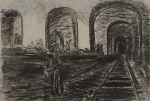
 During the war, the
premises survived the Blitz, and provided shelter, and First Aid and
Air Raid Wardens posts. The Gaffer kept in touch with the 600 old boys
and girls who were serving in the forces, and later published some of his
correspondence with them. He
and the Missus, and the choir, conducted Sabbath evening services in
various air raid shelters, including the notorious Tilbury shelter,
close to the Settlement, in the arches, vaults and cellars of the LMS
Goods Station and adjacent 8-storey warehouse. This was one of the
largest shelters, accommodating up to 16,000 - it had also been used as a
shelter in the First World War - and was described as a 'hell hole'.
Some improvements were made before the King and Eleanor Roosevelt visited in 1942.
During the war, the
premises survived the Blitz, and provided shelter, and First Aid and
Air Raid Wardens posts. The Gaffer kept in touch with the 600 old boys
and girls who were serving in the forces, and later published some of his
correspondence with them. He
and the Missus, and the choir, conducted Sabbath evening services in
various air raid shelters, including the notorious Tilbury shelter,
close to the Settlement, in the arches, vaults and cellars of the LMS
Goods Station and adjacent 8-storey warehouse. This was one of the
largest shelters, accommodating up to 16,000 - it had also been used as a
shelter in the First World War - and was described as a 'hell hole'.
Some improvements were made before the King and Eleanor Roosevelt visited in 1942. 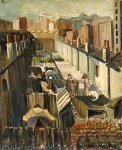
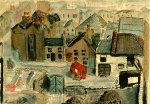 Rose, an avid self-taught artist - she served on the board
of the Whitechapel Gallery - painted many watercolours of the besieged
borough, including 'The Foothills, Tilbury, bombed second time' in 1941 [above right, plus her charcoal sketch of the shelter] - it was also drawn by official war artists Ardizzone and Moore - as well as the clear-up and triage activities of the Civilian
Defence Service,
bombed-out synagogues and churches, and scenes of everyday life around
the Settlement building, viewed from its roof. The Bancroft Library hosts an exhibition of
her paintings, Stepney in Peace and War, from November 2013 - 6 March 2014 - details here. Left are 'La Toilette' of 1930 - showing women washing in their back yards - and 'Berner Street Yard' of 1947; see also 'Coronation in Challis Court' (1937) and 'Next Day, Watney Street' (1941).
Rose, an avid self-taught artist - she served on the board
of the Whitechapel Gallery - painted many watercolours of the besieged
borough, including 'The Foothills, Tilbury, bombed second time' in 1941 [above right, plus her charcoal sketch of the shelter] - it was also drawn by official war artists Ardizzone and Moore - as well as the clear-up and triage activities of the Civilian
Defence Service,
bombed-out synagogues and churches, and scenes of everyday life around
the Settlement building, viewed from its roof. The Bancroft Library hosts an exhibition of
her paintings, Stepney in Peace and War, from November 2013 - 6 March 2014 - details here. Left are 'La Toilette' of 1930 - showing women washing in their back yards - and 'Berner Street Yard' of 1947; see also 'Coronation in Challis Court' (1937) and 'Next Day, Watney Street' (1941).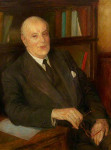 As wardens of the settlement, Basil [left, in his later years] and
Rose lived on site up to and beyond their retirement in 1947,
demonstrating their commitment to the area. It was at this point that
he was knighted for services to youth welfare. He was also a magistrate (chairman of the
East London Juvenile Court from 1936-55 - the painting left by T. Henry is at the present-day Thames Magistrates Court), President of the London Federation of Boys'
Clubs and involved with the [Royal] London Hospital. See further his
autobiography The Indiscretions of a Warden (Methuen 1937), followed by The Indiscretions of a Magistrate (1950), and L.L. Loewe Basil Henriques
(RKP 1976). There were other Jewish clubs with similar ideals (though
different approaches to Zionism), such as 'The Hutch', Brady
(at a Hanukkah party in 2013 the webmaster of this site met a former
member who described the all-girls' production of Gilbert and
Sullivan's HMS Pinafore
and sang from memory one of its numbers) and Victoria Boys (of which
Lionel Bart, né Begleiter, was a member). HaBonim is said to have been
founded in Cannon Street
Road in 1929 by Wellesley Aron and Norman Lourie, modelled on the
German Wandervogel movement, and espousing collective strength and
outdoor activities; Habonim Dror is now a major international secular socialist Zionist youth movement.
As wardens of the settlement, Basil [left, in his later years] and
Rose lived on site up to and beyond their retirement in 1947,
demonstrating their commitment to the area. It was at this point that
he was knighted for services to youth welfare. He was also a magistrate (chairman of the
East London Juvenile Court from 1936-55 - the painting left by T. Henry is at the present-day Thames Magistrates Court), President of the London Federation of Boys'
Clubs and involved with the [Royal] London Hospital. See further his
autobiography The Indiscretions of a Warden (Methuen 1937), followed by The Indiscretions of a Magistrate (1950), and L.L. Loewe Basil Henriques
(RKP 1976). There were other Jewish clubs with similar ideals (though
different approaches to Zionism), such as 'The Hutch', Brady
(at a Hanukkah party in 2013 the webmaster of this site met a former
member who described the all-girls' production of Gilbert and
Sullivan's HMS Pinafore
and sang from memory one of its numbers) and Victoria Boys (of which
Lionel Bart, né Begleiter, was a member). HaBonim is said to have been
founded in Cannon Street
Road in 1929 by Wellesley Aron and Norman Lourie, modelled on the
German Wandervogel movement, and espousing collective strength and
outdoor activities; Habonim Dror is now a major international secular socialist Zionist youth movement.
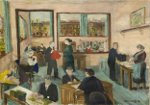
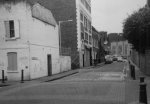
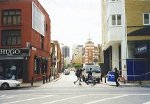
 In
1961, after Basil's death, Berner Street [left in 1938, and today] was renamed Henriques Street
in
his honour. Rose worked on: one of her post-war projects was the
creation of workshops for the elderly, providing light work (such as
button carding) and companionship for pensioners; the British Medical Journal
commended this scheme, and that of the similar Employment Fellowship - right is her oil painting of 1954.
In
1961, after Basil's death, Berner Street [left in 1938, and today] was renamed Henriques Street
in
his honour. Rose worked on: one of her post-war projects was the
creation of workshops for the elderly, providing light work (such as
button carding) and companionship for pensioners; the British Medical Journal
commended this scheme, and that of the similar Employment Fellowship - right is her oil painting of 1954.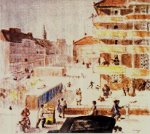 Rose continued to paint - in 1961 the Whitechapel Gallery had mounted an
exhibition of her work from 1935 onwards under the title 'Vanishing
Stepney'. Her hope was that local people would cherish all that had
been good about old Stepney while embracing the bright new world of what was to become Tower
Hamlets! - for example, right is her watercolour of around 1951 'Berner Street Fait Accompli'. She died in 1972.
Rose continued to paint - in 1961 the Whitechapel Gallery had mounted an
exhibition of her work from 1935 onwards under the title 'Vanishing
Stepney'. Her hope was that local people would cherish all that had
been good about old Stepney while embracing the bright new world of what was to become Tower
Hamlets! - for example, right is her watercolour of around 1951 'Berner Street Fait Accompli'. She died in 1972.